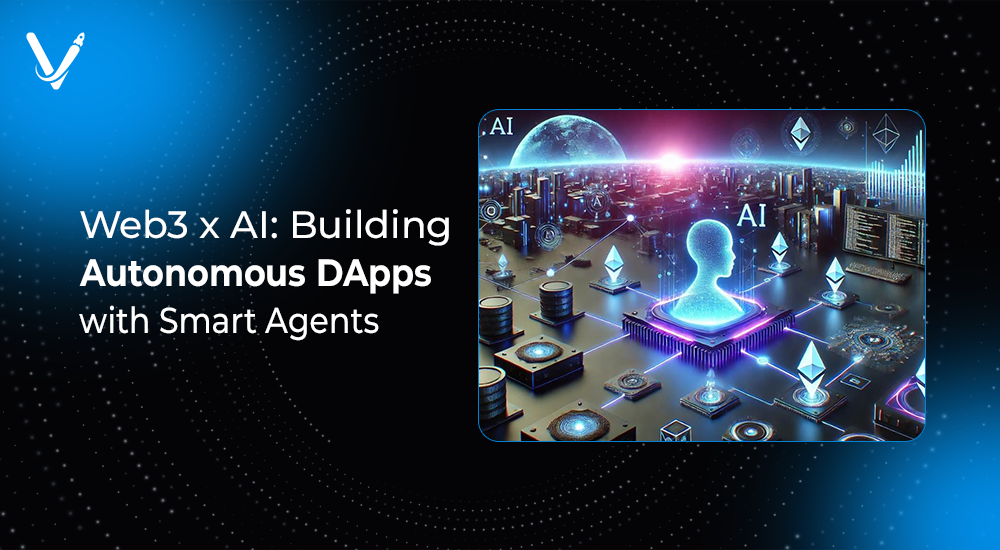Web3 x AI: Building Autonomous DApps with Smart Agents


- Aug 12, 2025



The digital landscape is evolving at a breathtaking pace, and two transformative forces—Web3 and Artificial Intelligence—are now intersecting in powerful ways. While Web3 promises decentralization, transparency, and user empowerment, AI brings adaptability, predictive capabilities, and decision-making intelligence. Together, they give rise to a new category of decentralized applications (DApps) that are no longer static or purely rules-based. Instead, they can analyze situations, make decisions, and act autonomously in real time.
In this article, we’ll explore how the fusion of Web3 and AI—through smart agents—is redefining what DApps can do. We’ll look at the core technologies involved, the opportunities for businesses, the architecture of such systems, and the trends that point to where we’re headed next.
Before diving into how Web3 and AI integrate, it’s crucial to understand the foundational concepts. Web3 sets the stage for decentralization and trustless interactions, while smart agents add the intelligence and autonomy needed for these systems to function with minimal human intervention.
Web3 is the third generation of the internet, characterized by decentralization, tokenized economies, and trustless interactions. Unlike Web2, which relies on centralized servers and corporate ownership, Web3 leverages blockchain technology to put ownership and control back into the hands of users.
Key characteristics include:
Smart agents are autonomous digital entities capable of perceiving their environment, processing information, and acting based on programmed objectives and learned experiences. In the Web3 context, they interact with smart contracts, decentralized protocols, and external data sources to complete tasks—ranging from executing financial trades to managing supply chains—without direct human oversight.
Their core capabilities include:
On their own, Web3 and AI are already transformative. But their combination creates a synergy that addresses each other’s limitations. AI’s decision-making power complements Web3’s transparent and tamper-proof execution environment, making autonomous, trustworthy applications a reality.
AI can make data-driven decisions, but in centralized systems, those decisions can be opaque and susceptible to manipulation. By integrating AI with Web3, the decision-making process and its execution become transparent and verifiable on the blockchain.
Smart agents can directly engage with DeFi protocols to handle lending, trading, or staking autonomously. This removes the need for human intermediaries, enabling 24/7 global economic activity.
Technologies like federated learning and zero-knowledge proofs enable AI models to train on decentralized datasets without revealing sensitive information, aligning perfectly with Web3’s emphasis on privacy.
The vision of AI-powered autonomous DApps sounds compelling, but making it work requires careful architecture. This involves defining layers, ensuring seamless integration between blockchain components and AI systems, and designing workflows that enable real-time, trustless automation.
The combination of Web3 and AI isn’t just a technical novelty—it has tangible business implications. Industries ranging from finance to logistics are already experimenting with AI-powered smart agents to create more efficient, responsive, and autonomous solutions.
AI-driven agents can track market volatility, manage liquidity, and adjust asset allocations dynamically to optimize returns.
Agents monitor price trends, rarity scores, and community sentiment to automate NFT bidding and selling strategies.
AI agents can vote on proposals based on members’ preferences, ensuring informed and consistent participation.
Agents can trigger payments when IoT sensors confirm delivery, forecast demand, and manage supplier negotiations autonomously.
AI-driven NPCs can create more immersive game environments, handling player interactions in ways that evolve over time.
While the opportunities are immense, building autonomous DApps with smart agents isn’t without hurdles. These challenges span technical limitations, governance complexities, and ethical considerations that need to be addressed for sustainable adoption.
Running AI computations on-chain can be prohibitively expensive. Hybrid approaches like off-chain processing with on-chain verification are key.
For agents to reach full potential, they must seamlessly operate across multiple blockchain ecosystems.
With financial control comes vulnerability—security audits, fail-safes, and multi-sig setups are non-negotiable.
Fairness, accountability, and transparency are vital to prevent biased or harmful decision-making.
The convergence of Web3 and AI is still in its early stages, but the trajectory is clear. In the coming years, we can expect richer, more interconnected ecosystems where autonomous agents are not the exception but the norm.
Markets where AI agents represent individuals, companies, or even other AI systems to transact directly.
Blockchain-powered incentives for decentralized AI training will make models more transparent and community-owned.
Smart agents will connect blockchain ecosystems with real-world devices, enabling automated logistics, energy distribution, and smart city management.
From financial advising to healthcare, autonomous agents will deliver hyper-personalized solutions at scale.
The combination of Web3 and AI through smart agents is more than just a technological experiment—it’s a glimpse into the future of self-sustaining, intelligent, and user-centric applications. As businesses embrace these tools, they’ll find opportunities to innovate in ways that were previously unimaginable.
At Vasundhara Infotech, we specialize in developing blockchain-powered, AI-driven solutions tailored to your business needs. Whether you’re envisioning a fully autonomous DApp or integrating AI agents into an existing platform, we have the expertise to bring your idea to life.
Copyright © 2025 Vasundhara Infotech. All Rights Reserved.